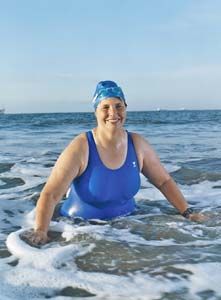The Big Question: How Do You Swim in Really Cold Water?
Lynne Cox’s strange and wonderful relationship with the coldest waters on the planet began as a youngster turning blue on the coastal beaches of Maine and New Hampshire. She went on to set world records for duration and distance in a variety of exotic cold-water settings, first as a teen crossing the English Channel, and […]

Seal Beach, California: The Pacific is Lynne Cox’s home base today, but this courageous world-class athlete first reached for her dream in New England’s waters.
Photo Credit : Greenwood, J.P.Lynne Cox’s strange and wonderful relationship with the coldest waters on the planet began as a youngster turning blue on the coastal beaches of Maine and New Hampshire. She went on to set world records for duration and distance in a variety of exotic cold-water settings, first as a teen crossing the English Channel, and most recently as a 45-year-old swimming beside icebergs in Antarctica.
Her memoirs of her experiences — “Swimming to Antarctica” and “Grayson” — have earned her a legion of ardent fans and high marks from reviewers. We caught up with Lynne on her book tour, just after a dip on a chilly, rainy day at Good Harbor Beach in Gloucester, Massachusetts.
“My dad was a physician, and he really believed that you needed to acclimate to the cold and that the only way to do it was to swim in colder water. Our parents took us to Hampton Beach and Rye, New Hampshire, and up the coast of Maine. My brother and sisters and I were all competitive, and it was like, ‘Who can stay in the water longest?’
“Everybody relates to swimming across the English Channel — I did that when I was 15 years old, breaking the men’s and women’s records. My time [9 hours 57 minutes] was broken by Davis Hart of Springfield College in Massachusetts, so I went back and broke his time when I was 16. It was like, ‘OK, so now you’ve climbed Everest — now what do you do?’
“In 1987 I swam across the Bering Strait. The water temperature was 42 degrees, and it dropped to 38 by the end of the swim. I was in the water for two hours six minutes. After that I looked at other swims, and the most notable in terms of extremely cold water was the one I did in December 2002 in Neko Harbor, Antarctica. I swam 1.22 miles in 32-degree water, and it dropped to 30 at times when I was near the iceberg. I was in the water exactly 25 minutes.
“People want to know, ‘How is it possible to swim in 32-degree water in a bathing suit and goggles?’ It really was the ultimate test. In the Antarctic summer, something like 80 percent of the sea ice melts into the ocean. The temperature rises to 32 degrees. ‘Could it be done?’ I really do equate it to the first human-powered flight. People have so much imagination and creativity and ability, and all that comes together with discipline — a lot of discipline — and focus and training.
“The Antarctica swim took two years of planning — huge, detailed planning for the two weeks leading up to it. Who’s going to provision the boat? Who’s going to pull me out of the water if something goes wrong? Where are the defibrillators? Are we going to heat up IV solution so that we can rewarm the core from the inside out? There’s all this stuff.
“There are huge concerns when you first immerse yourself in 32-degree water. If you overstimulate the vagus nerve, you can go into cardiac arrest. The other thing that can occur is cold-water immersion injury. Basically, your peripheral nerves get fried by the cold and you lose sensitivity to heat and cold. It’s sort of like neuropathy.
“In that kind of cold water you can lose heat so rapidly. The mind has to stay so focused on what’s going on with the body. Are my fingers staying together or are they splaying? If they’re splaying — coming apart — that means I’m losing fine motor control and my brain is cooling down and I’m in trouble. Is there blood pooling on my shoulders? Are they turning purple? That’s not a good sign, either. Are my teeth chattering while I’m swimming? I should be out of the water.
“I have very well-distributed body fat that helps keep me insulated. I also have a lot of muscle mass that I’ve worked really hard to develop. It gives me power and strength; it’s also the energy factory that creates the heat to keep me warm. If I were just a big person, I wouldn’t do as well in cold water. Beyond all that, it’s mental attitude: wanting to do it, really desiring to try something extraordinary.
“A lot of people are like, ‘She doesn’t feel the cold.’ I feel the cold! But the focus isn’t on ‘Oh, it’s cold!’ You feel it, but then you get in it and the focus is on movement, on processing information — on the texture of the water, the color, the saltiness of it, the way the cloud patterns move across the surface. All this water memory comes back to me, and I relax.”


